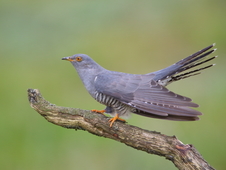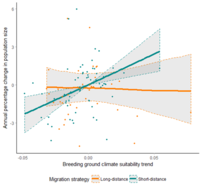
Many Afro-Palaearctic long-distance migrants have declined significantly over the last 50 years. Climate change and land use change have been suggested as possible drivers of this decline. Howard et al. (2020) analysed annual abundance data of 100 migratory species over a 36-year period in relation to trends in climate and land cover suitability across breeding and non-breeding sites. Population trends tended to be more closely related to climate suitability than changes in land cover at breeding sites, but the converse tended to be the case at non-breeding sites. Short-distance migrants have benefitted from increased climate suitability at breeding sites, but long-distance migrants have not. Long-distance migrants have also suffered declines in the extent of suitable habitat across their sub-Saharan non-breeding grounds. The combined effects of climate and land cover change only accounted for approximately 40% of the variation in migratory species’ population trends, suggesting that other factors are also involved.

Afro-Palaearctic long-distance migratory species are declining more rapidly than short-distance migratory or resident species (Cresswell 2014, Gregory et al. 2019, Sanderson et al. 2006, Vickery et al., 2014). It has been suggested that these declines may be partially explained by the effects of climate change and land use change (Both et al. 2006, Jiguet et al. 2010, Kirby et al. 2008, Stephens et al. 2016, Studds et al. 2017, Vickery et al. 2014). Howard et al. (2020) looked at the relative importance of climate change and land cover change at breeding and non-breeding grounds on long-term population trends of migratory species. Annual abundance data from the Pan-European Common Bird Monitoring Scheme (PECBMS) was used to study population trends of 39 long-distance migrants and 61 short-distance migrants over a 36-year period (1980–2016). Populations of short-distance migrants have remained relatively stable since 1980, but long-distance migrants have slowly declined. Howard et al. (2020) analysed these population trends in relation to trends in land cover and climate suitability across breeding and non-breeding grounds.
Population trends of migrant birds tended to be more closely related to changes in climate than changes in land cover on their breeding grounds, with an overall positive relationship between climate suitability and population trends. However, this relationship differed between migratory strategies—long-distance migrants had not significantly benefitted from an increase in climate suitability—whereas short-distance migrants had. Their dependence on multiple widely dispersed areas at different times of year renders long-distance migrants more vulnerable to environmental change than their resident counterparts. For example, climate change may lead to a mismatch between the breeding period of insectivorous migratory birds and the peak abundance of their insect prey at breeding sites (Both et al. 2006). Milder winters may also boost the overwinter survival of resident species, creating stronger competition for breeding resources to the detriment of those that arrive at the breeding grounds last (Berthold et al. 1998, Pearce-Higgins et al. 2015).
In contrast, on migratory species’ non-breeding grounds, land cover change tended to be of greater importance than climate change in explaining population trends. Anthropogenic land use change such as the intensification of agriculture may cause population declines by reducing the quantity and/or quality of suitable habitat at overwintering sites. There has been an approximately 5% decrease in the extent of suitable land cover at the non-breeding grounds of long-distance migrants (Howard et al. 2020), reflecting extensive changes in land-management across sub-Saharan Africa, particularly in the Sahel region (Adams et al. 2014). The relationship between land cover suitability and population trends suggests that this may be one of the factors driving the decline in long-distance migrants.
It is important to note that the combined effects of climate and land-cover change only accounted for around 15% of the variation in population trends of long-distance migratory species and 31% in short-distance migrants. This suggests that a number of other factors are involved in the observed population declines. The dependence of long-distance migrants on multiple landscapes throughout the year exposes them to a wide range of site-specific threats such as hunting, habitat loss, and invasive species. More information is needed on the locations of stopover sites and their associated threats before we fully understand the reasons behind the ongoing decline of migratory species.
Links
PanEuropean Common Bird Monitoring Scheme
References
Adams, W. M., Small, R. D. S. and Vickery, J. A. (2014) The impact of land use change on migrant birds in the Sahel. Biodiversity, 15: 101–108.
Berthold, P., Fiedler, W., Schlenker, R. and Querner, U. (1998) 25-year study of the population development of central European songbirds: A general decline most evident in long‐distance migrants. Naturwissenschaften, 85: 350–353.
Both, C., Bouwhuis, S., Lessells, C. M. and Visser, M. E. (2006) Climate change and population declines in a long-distance migratory bird. Nature, 441: 81–83.
Cresswell, W. (2014) Migratory connectivity of Palaearctic‐African migratory birds and their responses to environmental change: The serial residency hypothesis. Ibis, 156: 493–510.
Gregory, R. D., Skorpilova, J., Vorisek, P. and Butler, S. (2019) An analysis of trends, uncertainty and species selection shows contrasting trends of widespread forest and farmland birds in Europe. Ecol. Indic., 103: 676–687.
Howard, C., Stephens, P. A., Pearce-Higgins, J. W., Gregory, R. D., Butchart, S. H. M. and Willis, S. G. (2020) Disentangling the relative roles of climate and land cover change in driving the long-term population trends of European migratory birds. Divers. Distrib., 26: 1442–1455.
Jiguet, F., Gregory, R. D., Devictor, V., Green, R. E., Vorisek, P., Van Strien, A. and Couvet, D. (2010) Population trends of European common birds are predicted by characteristics of their climatic niche. Glob. Change Biol. 16: 497–505.
Kirby, J. S., Stattersfield, A. J., Butchart, S. H. M., Evans, M. I., Grimmett, R. F. A., Jones, V. R., … Newton, I. (2008) Key conservation issues for migratory land‐and waterbird species on the world’s major flyways. Bird Conserv. Int., 18: S49–S73.
Pearce-Higgins, J. W., Eglington, S. M., Martay, B. and Chamberlain, D. E. (2015) Drivers of climate change impacts on bird communities. J. Anim. Ecol., 84: 943–954.
Sanderson, F. J., Donald, P. F., Pain, D. J., Burfield, I. J. and van Bommel, F. P. J. (2006). Long-term population declines in Afro-Palearctic migrant birds. Biol. Conserv., 131: 93–105.
Stephens, P. A., Mason, L. R., Green, R. E., Gregory, R. D., Sauer, J. R., Alison, J., … Willis, S. G. (2016) Consistent response of bird populations to climate change on two continents. Science, 352: 84–87.
Studds, C. E., Kendall, B. E., Murray, N. J., Wilson, H. B., Rogers, D. I., Clemens, R. S., Fuller, R. A. (2017) Rapid population decline in migratory shorebirds relying on Yellow Sea tidal mudflats as stopover sites. Nat. Commun., 8: 14895.
Vickery, J. A., Ewing, S. R., Smith, K. W., Pain, D. J., Bairlein, F., Škorpilová, J., & Gregory, R. D. (2014) The decline of Afro-Palaearctic migrants and an assessment of potential causes. Ibis, 156: 1–22.
Acknowledgements
Compiled: 2020
Recommended Citation:
BirdLife International (2020)
Climate change at breeding grounds and land cover change at non-breeding grounds affect long-term population trends of European migratory birds.
Downloaded from https://datazone.birdlife.org/sowb/casestudy/climate-change-at-breeding-grounds-and-land-cover-change-at-non-breeding-grounds-affect-long-term-population-trends-of-european-migratory-birds on 22/12/2024